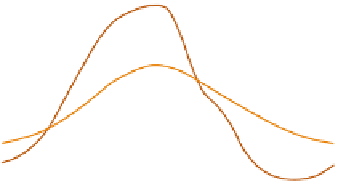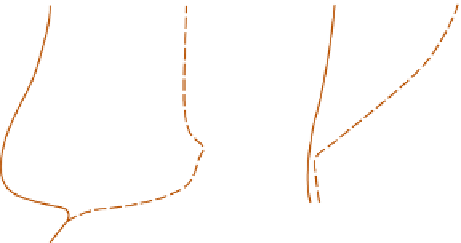Geoscience Reference
In-Depth Information
(A)
2
Wind speed
. This is at a minimum in the upper
crop canopy where the foliage is most dense.
There is a slight increase below and a marked
increase above.
3
Water vapor
. The maximum diurnal evapo-
transpiration rate and supply of water vapor
occurs at about two-thirds the crop height
where the canopy is most dense.
4
Carbon dioxide
. By day, CO
2
is absorbed
through photosynthesis of growing plants
and at night is emitted by respiration. The
maximum sink and source of CO
2
is at about
two-thirds the crop height.
June day
R
n
= 112
December day
LE
= 65
H
= 38
R
n
= 19
H
= 9
Lower
atmosphere
Grass
ca
no
py
Δ
S
= -5
Δ
S
= 14
Δ
S
= -10
G
= 10
Soil
300
(B)
R
n
200
LE
Finally, we examine the conditions accom-
panying the growth of irrigated crops.
Figure
12.10
illustrates the energy relationships in a
1m-high stand of irrigated Sudan grass at Tempe,
Arizona, on 20 July 1962. The air temperature
varied between 25 and 45
100
H
G
0
-100
C. By day, evapo-
transpiration in the dry air was near its potential
and
LE
(anomalously high due to a local tempera-
ture inversion) exceeded
Rn
, the deficiency being
made up by a transfer of sensible heat from the air
(
H
negative). Evaporation continued during the
night due to a moderate wind (7m s
-1
) sustained
by the continued heat flow from the air. Thus
evapotranspiration leads to comparatively low
diurnal temperatures within irrigated desert
crops. Where the surface is inundated with water,
°
J
FM
A
M
J
J
A
S
O
N
D
J
Month
Figure 12.8
Energy fluxes over short grass near
Copenhagen (56°N). A: Totals for a day in June (17
hours' daylight; maximum solar altitude 58°) and
December (7 hours' daylight; maximum solar
altitude 11°). Units are Wm
-2
. B: Seasonal curves
of net radiation (Rn), latent heat (LE), sensible heat
(H) and ground-heat flux (G).
Source: Data from Miller (1965); and after Sellers (1965).
300
200
Crop height
100
0
0
100
200
-50
Temperature (°C)
Wind velocity (cm s
-1
)
Figure 12.9
Temperature and wind velocity profiles within and above a meter-high stand of barley at
Rothamsted, southern England, on 23 July 1963 at 01:00-02:00 hours and 13:00-14:00 hours.
Source: After Long et al. (1964). By permission of Meteorologische Rundschau.






































































































































